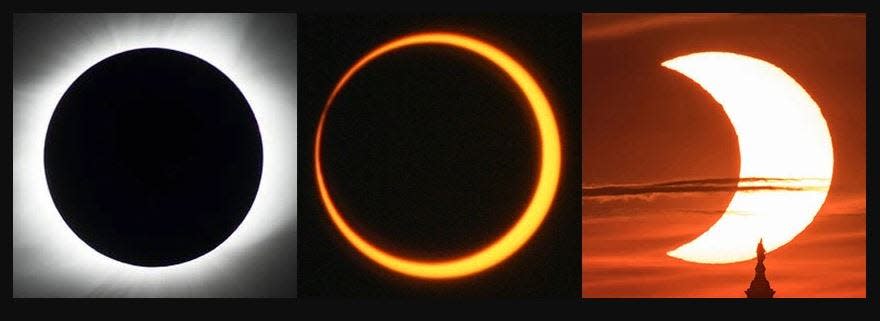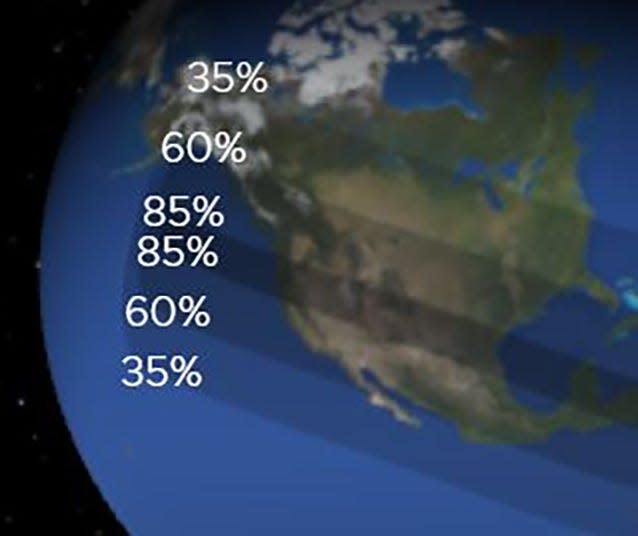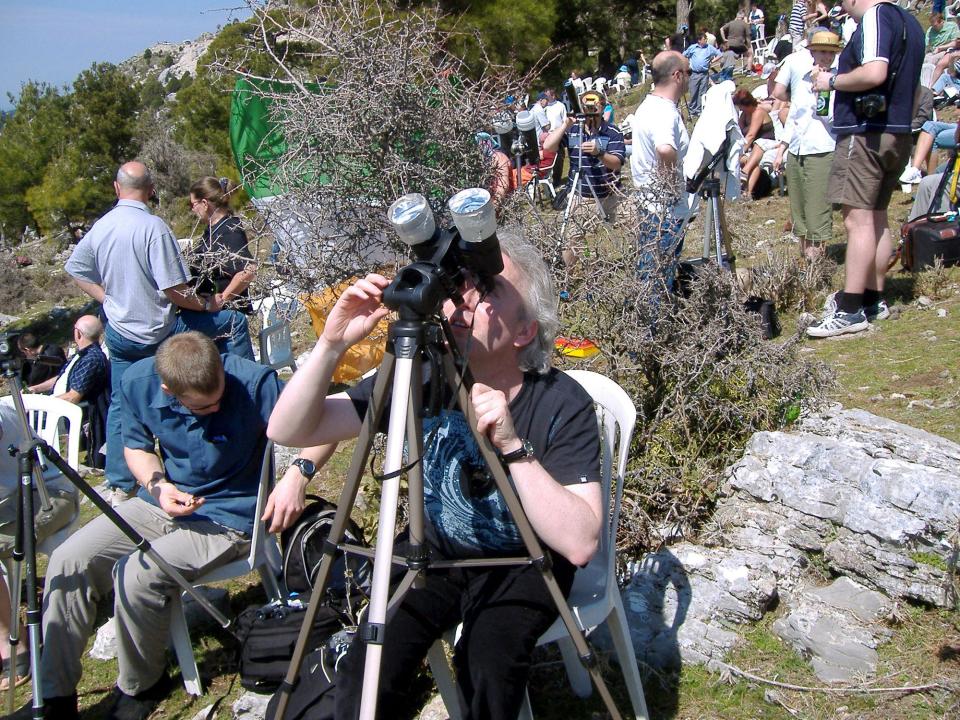Find out where to watch the annular solar eclipse and 'ring of fire' in the North State
Get ready for a "ring of fire" to gleam over the North State on Saturday, Oct. 14.
For the price of a safe pair of eclipse glasses, North State residents can watch an annular solar eclipse darken the sky that morning.
“At its maximum, about 90% of the sun will be covered by the moon,” said Dunsmuir resident Russ Adamson, president of the Mt. Shasta Stargazers astronomy club.
Here’s what will happen and where and how to view it best.
What you'll see if skies are clear
A solar eclipse occurs when the moon passes between the sun and Earth. The moon blocks part or all of our view of the sun, casting a shadow over parts of Earth's surface.
Note to readers: If you appreciate the work we do here at the Redding Record Searchlight, please consider subscribing yourself or giving the gift of a subscription to someone you know.
There are four kinds of solar eclipses, according to NASA.
Total eclipses happen when the moon completely blocks our view of the sun's disk, although sometimes people can see the sun's bright outer atmosphere, a halo-like corona. The next total solar eclipse over the U.S. will be on April 8, 2024.
Annular eclipses ― like the one on Oct. 14 ― happen when the moon is far from Earth in its orbit. Because the moon looks smaller from our perspective, it doesn’t quite cover the sun. When the edges of the sun are visible around the moon, it creates the beautiful golden “ring of fire” effect at the height of the eclipse.

Partial eclipses happen when the sun, moon and Earth don’t line up perfectly. The moon blocks part of the sun, giving it a crescent appearance.
Hybrid eclipses happen when an eclipse looks annular from some locations on Earth, but appears total from other places.
When to watch
The eclipse will begin about 8:05 a.m. on Oct. 14. Spectators with proper equipment will see the dark circle of the moon start inching its way across Earth’s view of the sun.
The eclipse peaks at 9:20 a.m. That’s when the moon will cover as much of the sun as it ever will during this stellar event.
The moon will move away from the sun at about 10:40 a.m., Adamson said.
Where to view the eclipse
People in California, Nevada, Oregon and Texas will be able to see at least part of the ring of fire as the moon passes over the sun, according to NASA.
The closer you are to the center line of the shadow's path ― the darkest part, or the umbra ― “the more the moon will be centered (over) the sun and the greater the ‘ring of fire’ effect will be," Adamson said. In Yreka, he said, you'll see 88% of the sun blocked by the moon, while in Redding you'll see 85% and those in Sacramento will see 80%.

Views are best along the center line, which stretches diagonally across Oregon. So if skies aren't cloudy, take a road trip north if you want the best possible view, he said.
Adamson recommends these routes to the center line:
From the Interstate 5 corridor (Redding, Mount Shasta, Dunsmuir, Yreka): Take I-5 north to Oregon. Stop to view between Ashland and Corvallis. Best views are at the center line around Yoncalla, 175 miles north of Yreka and 273 miles north of Redding.
East of Weed: Take Highway 97 and stop anywhere between Dorris, just south of the Oregon border, and Sunriver, Oregon, south of Bend. The center line is just northeast of Crater Lake National Park and south of Beaver Marsh, about 125 miles northeast of Weed.
From Modoc County: From Alturas, head north on Highway 395 to Lakeview, Oregon — about 50 miles. The center line is between Lakeview and Valley Falls, Oregon.
To see an updated map of the shadow’s predicted path, go to EclipseWise.com.
Hobnob with other eclipse fans by checking online for eclipse parties at your Oregon destination. These include EclipseFest 2023, a six-day bash 20 miles from Crater Lake National Park in Klamath County. Besides the watch party, the Oct. 10 to 15 program includes camping, vendor booths and a concert by American rock band Smash Mouth the evening after the moon eclipses the sun. With free eclipse glasses to the first 5,000 people, eclipse-chasers might as well be, as the band put it, "Walkin on the Sun." Find more information at eclipsefest23.com.
Watch safely
Remember what grownups told the kids: Never look directly at the sun or you’ll damage your eyes.
NASA agrees with those grownups.

“It’s not safe to look directly at the sun,” even during an eclipse, “without specialized eye protection for solar viewing,” according to NASA's eclipse safety web page.
Only buy solar glasses from a reputable company and make sure they comply with the ISO 12312-2 international safety standard. Go to eclipse.aas.org/eye-safety/iso12312-2 for more information.
“The key factor when buying online is to make sure the glasses or solar filter meets transmission requirements,” Adamson said. He recommends consumers look for the following code: ISO 12312-2:2015(E)
Many telescope, camera and binocular companies make or recommend brands of solar viewing filters for their products. If you buy one, get a filter that's correct for your model, manufacturers said. Call customer service if you're in doubt.
According to NASA, viewing any part of the sun through a camera lens, binoculars or a telescope without a special-purpose solar filter secured over the front of the optics will "instantly cause severe eye injury."
If you buy eclipse glasses, never use them with another magnifying device, like binoculars, according to Orion Telescopes & Binoculars' customer service staff. The sun may melt the plastic glasses through device and burn your eyes or face.
Go to the Solar Eclipse Safety page to read NASA’s recommendations for viewing devices that fit most budgets and for more information on watching safely.
Jessica Skropanic is a features reporter for the Record Searchlight/USA Today Network. She covers science, arts, social issues and news stories. Follow her on Twitter @RS_JSkropanic and on Facebook. Join Jessica in the Get Out! Nor Cal recreation Facebook group. To support and sustain this work, please subscribe today. Thank you.
This article originally appeared on Redding Record Searchlight: Watching: The annular solar eclipse across the North State on Oct. 14.

